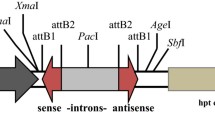Abstract
Key message
Intron-spliced hairpin RNAi construct targeting the exonic region of BjuMYB28 driven by the native promoter is the best suited strategy for developing viable low glucosinolate lines in polyploid Brassica juncea.
Abstract
Targeted silencing of specific homolog(s) of a multigene family in polyploids through RNA interference (RNAi) is a challenging effort. Indian oilseed mustard (Brassica juncea), a natural allotetraploid, is expected to have 4–6 copies of every Arabidopsis gene ortholog. In the current study, we have attempted to establish the best gene silencing system suitable for BjuMYB28, a transcription factor gene, with the objective of developing low seed glucosinolate lines in B. juncea. After comparing multiple combinations of BjuMYB28 gene homologs, promoters, target regions (exon and 3′ UTR) and silencing strategies (RNAi and antisense), we suggest that the intron-spliced hairpin RNAi construct targeting the specific exonic region of the BjuMYB28 gene under the control of native promoter, whose peak activity synchronises with the highest glucosinolate accumulation phase of the plant, is the best suited strategy for developing viable low glucosinolate lines in polyploid B. juncea.


Similar content being viewed by others
Abbreviations
- GSL:
-
Glucosinolate
- RNAi:
-
RNA inerference
- siRNA:
-
Small interfering RNA
- UTR:
-
Untranslated region
- DW:
-
Dry weight
- CDS:
-
Coding sequences
References
Adams KL (2007) Evolution of duplicate gene expression in polyploid and hybrid plants. J Heredi 98:136–141
Augustine R, Majee M, Gershenzon J, Bisht NC (2013a) Four genes encoding MYB28, a major transcriptional regulator of aliphatic glucosinolate pathway, are differentially expressed in the allopolyploid Brassica juncea. J Exp Bot 64:4907–4921
Augustine R, Mukhopadhyay A, Bisht NC (2013b) Targeted silencing of BjMYB28 transcription factor gene directs development of low glucosinolate lines in oilseed Brassica juncea. Plant Biotechnol J 11:855–866
Bisht NC, Gupta V, Ramchiary N, Sodhi YS, Mukhopadhyay A, Arumugam N, Pental D, Pradhan AK (2009) Fine mapping of loci involved with glucosinolate biosynthesis in oilseed mustard (Brassica juncea) using genomic information from allied species. Theor Appl Genet 118:413–421
Canola Council of Canada (2017). https://www.canolacouncil.org/oil-and-meal/what-is-canola/. Accessed 2018
Chen ZJ, Ha M, Soltis D (2007) Polyploidy: genome obesity and its consequences. In: Polyploidy workshop: plant and animal genome XV, conference, San Diego, CA, USA, New Phytol vol 174, 4, pp 717–720
Cullen BR (2006) Enhancing and confirming the specificity of RNAi experiments. Nat Methods 3:677–681
Halkier BA, Gershenzon J (2006) Biology and biochemistry of glucosinolates. Annu Rev Plant Biol 57:303–333
Kusaba M (2004) RNA interference in crop plants. Curr Opin Biotechnol 15:139–143
Lawrence RJ, Pikaard CS (2003) Transgene-induced RNA interference: a strategy for overcoming gene redundancy in polyploids to generate loss-of-function mutations. Plant J 36:114–121
Mocellin S, Provenzano M (2004) RNA interference: learning gene knock-down from cell physiology. J Transl Med 2:39
Persengiev SP, Zhu X, Green MR (2004) Nonspecific, concentration-dependent stimulation and repression of mammalian gene expression by small interfering RNAs (siRNAs). RNA 10:12–18
Ramchiary N, Bisht NC, Gupta V, Mukhopadhyay A, Arumugam N, Sodhi YS, Pental D, Pradhan AK (2007) QTL analysis reveals context-dependent loci for seed GSL trait in the oilseed Brassica juncea: Importance of recurrent selection backcross (RSB) scheme for the identification of ‘true’ QTL. Theor Appl Genet 116:77–85
Rossak M, Smith M, Kunst L (2001) Expression of the FAE1 gene and FAE1 promoter activity in developing seeds of Arabidopsis thaliana. Plant Mol Biol 46:717–725
Sodhi YS, Mukhopadhyay A, Arumugam N, Verma JK, Gupta V, Pental D, Pradhan AK (2002) Genetic analysis of total glucosinolate in crosses involving a high glucosinolate Indian variety and a low glucosinolate line of Brassica juncea. Plant Breed 121:508–511
Toroser D, Griffiths H, Wood C, Thomas DR (1995) Biosynthesis and partitioning of individual glucosinolates between pod walls and seeds and evidence for the occurrence of PAPS: desulphoglucosinolate sulphotransferase in seeds of oilseed rape (Brassica napus L.). J Exp Bot 46:1753–1760
Wesley SV, Helliwell CA, Smith NA, Wang MB, Rouse DT, Liu Q, Gooding PS, Singh SP, Abbott D, Stoutjesdijk PA, Robinson SP, Gleave AP, Green AG, Waterhouse PM (2001) Construct design for efficient, effective and high-throughput gene silencing in plants. Plant J 27:581–590
Yang TJ, Kim JS, Kwon SJ et al (2006) Sequence-level analysis of the diploidization process in the triplicated FLC region of Brassica rapa. Plant Cell 18:1339–1347
Yang J, Liu D, Wang X, Ji C, Cheng F, Liu B, Hu Z, Chen S, Pental D, Zhang M (2016) The genome sequence of allopolyploid Brassica juncea and analysis of differential homoeolog gene expression influencing selection. Nat Genet 48:1225–1232
Acknowledgements
Research was supported by project grants (BT/PR10268/27/81/2007 and BT/PR2171/AGR/36/687/2011) from DBT (India) to NCB. RA was supported from JRF of CSIR (India) and Short Term Research Fellowship of NIPGR (New Delhi).
Author information
Authors and Affiliations
Corresponding author
Ethics declarations
Conflict of interest
The authors declare that they have no conflict of interest.
Additional information
Communicated by Renate Schmidt.
Electronic supplementary material
Below is the link to the electronic supplementary material.
Rights and permissions
About this article
Cite this article
Augustine, R., Bisht, N.C. Targeted silencing of genes in polyploids: lessons learned from Brassica juncea-glucosinolate system. Plant Cell Rep 38, 51–57 (2019). https://doi.org/10.1007/s00299-018-2348-8
Received:
Accepted:
Published:
Issue Date:
DOI: https://doi.org/10.1007/s00299-018-2348-8




